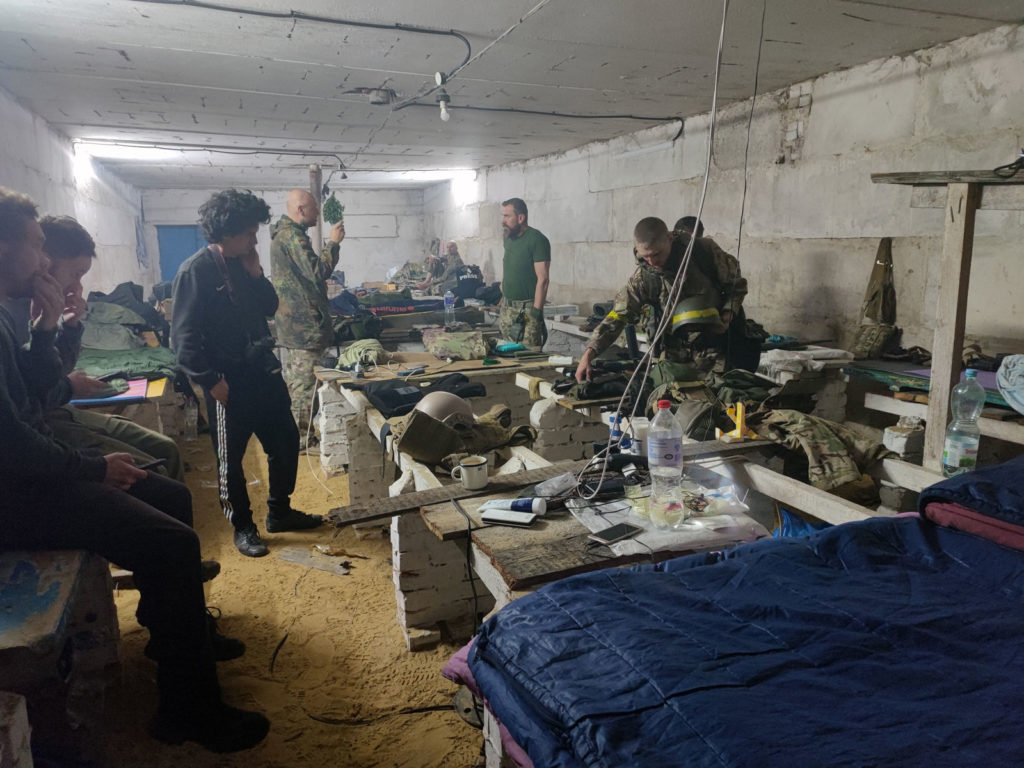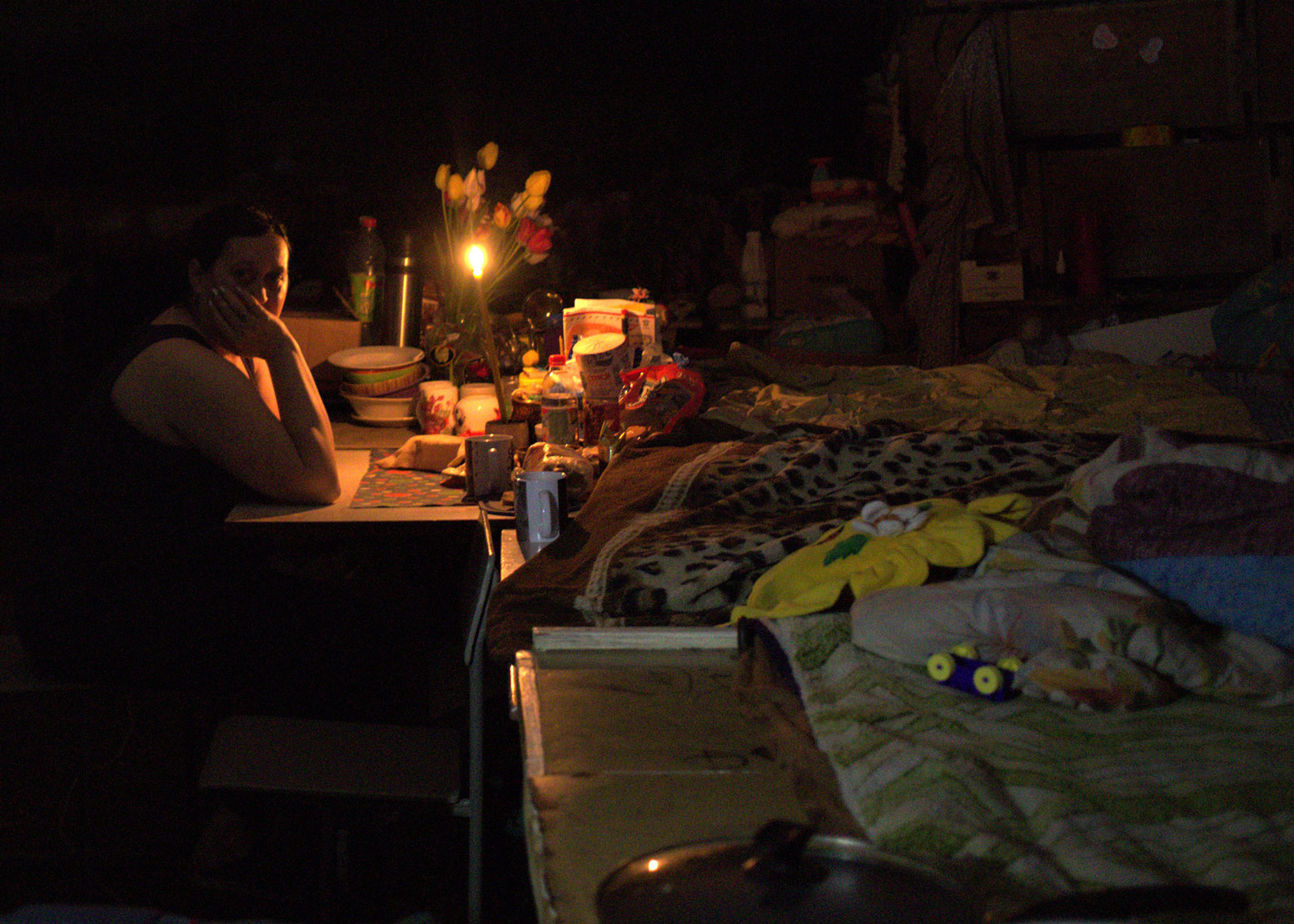We can see the rockets landing in the field in front of us, around a mile away from the frontline barracks we are holed up in. A shell whistles over our head only to smash into the forest next to us, but the birds don’t even wait for the smoke to clear before you can hear their melodic singing waft from the trees along with the plumes of white smoke. With a bright blue twilight sky and the yellow of the endless wheat fields around us, this part of the Donbas is an eerily beautiful arena for the carnage of the worst battle of the war in Ukraine so far. The artillery shelling is “constant,” a soldier tells us. So constant that he’s bored by it. Throughout the night, we hear dozens of explosions, some of which are close enough to shake the foundations of the base. This base is a handful of miles from Russian positions near the city of Izyum, and it is supposedly the quietest part of the Donbas front line.
The mostly volunteer soldiers at this base have an extraordinary mix of talents. There are Stanislav and Oksana, a young couple who are both lawyers studying for their doctorates in Kyiv. There are “Akademic” and “Okson,” who both have doctorate degrees in arts and philosophy but now serve in the trenches as snipers. One young soldier here was a member of the team that hunted down the Russian assassination squads sent to kill Ukraine President Volodymyr Zelenskyy in Kyiv in the opening days of the war. All the soldiers serving are fiercely patriotic and committed to their country’s freedom. They are Ukraine’s best and brightest. And every day, men and women like them are getting torn to pieces by Russian artillery in the fields of the Donbas. What we witnessed was similar to scenes we could see throughout the region.
The day before, we watched a dark blue van limp its way down the cracked road to Soledar toward a Ukrainian checkpoint. The front tires were burst, and the windshield was riddled with bullet holes. It was a mystery how it was still roadworthy or how anyone inside was still alive. Behind the van was a civilian car with the owner’s possessions strapped to its roof. The driver was in tears and looked like he was having a panic attack. The previous night, we had seen reports of a rapid Russian breakout from the town of Popasna, where they had been building up for a major assault for days. “They are 5 kilometers [3 miles] away from Soledar,” a Ukrainian press officer said when we asked them whether it was possible to visit the town to assess the situation. This was an extraordinary stride of 12 miles from their previous positions. When we arrived at the closest checkpoint, the Ukrainian soldiers stationed gave us a quizzical look and said, “You can go, I suppose, but we cannot guarantee your safety.”
Rubble and glass were scattered all over the ground as the thuds and booms of nearby shells rang out all around us. The town was deserted, but just down the road from there, a large Ukrainian tank covered in leaves for camouflage patrolled. It swiveled its turret toward our car for a brief second before rumbling past us.
Just a few days before, Soledar had been mostly untouched by Russia’s ruthless assault on the Donbas. Now it has become one of the most important front lines in the entire theater. An artillery duel was playing out on either side of the road to this strategic town. U.K. and U.S. intelligence assessments had suggested that the Russian offensives were stalling in the Donbas, making only marginal gains in exchange for extremely heavy casualties. Some observers even predicted a stalemate or a Ukrainian counteroffensive such as those seen in Kharkiv and Kyiv. This is not what we have been seeing on the ground. The state of the van and the chaos around us suggested that the Russians were close enough that they were exchanging small-arms fire.
Soledar is just down the road from Bakhmut, which is the center of Ukrainian resistance in this area. Normally a small, forgettable town of around 30,000, Bakhmut had taken on huge strategic importance because of its position straddling the road to Sievierodonetsk. This city has been the temporary administrative capital of Luhansk region ever since it was captured by Russian proxy separatist forces in 2O14. Now it is surrounded on three sides by the Kremlin’s forces, and the road via Bakhmut is the only way to relieve or resupply the city. The Russians have been blanketing the city with explosives for weeks, and officials estimate that as many as two-thirds of the buildings in the city are damaged beyond repair. The soldiers stationed there call it “the next Mariupol” and were discussing what would happen if they had to abandon the city and blow the bridges to allow a retreat into more defensible territory.

It is a dangerous and damaged road now well within the range of Russian artillery. A team of Agence France-Presse journalists staying at our hotel returned wide-eyed and ashen faced. They had come under serious shellfire and had been forced to run for cover in a trench. Some of the fire had landed mere yards away from them. Not everyone who had used the road was so lucky. The previous week, when we visited Lysychansk, a city just across the river from Sievierodonetsk, it was clear how precarious the position was. On the drive into the city, we passed a small gathering of military trucks and regular cars on the side of the road. When we returned about two hours later, they were in flames, the victims of a direct hit by Russian artillery.
It is all the more credit to the extraordinary and almost reckless bravery of Zelenskyy that he made an unannounced visit to both Soledar and Lysychansk on June 5 to congratulate his troops and raise morale. The Ukrainians have been saying that they have taken back much of the territory within Sievierodonetsk they had already lost and that they plan to defend the city to the end. Working out who controls what in this area on a day-to-day basis is virtually impossible.
Zelenskyy’s tone on the Donbas battles has darkened noticeably in recent days as Russia tries to press its advantage in armor and artillery before Western weapons systems arrive and there is a chance to turn the tide Ukraine’s way. He has described the situation in dire terms, noting that up to 100 Ukrainian soldiers could be dying each day in the Donbas alone. He referred to the region as being “destroyed” and called it “hell” while begging Western leaders for more heavy weaponry. Maksym Sutovoi, the first deputy mayor of Bakhmut, told us that the Russians were not taking cities but leveling them and moving into the rubble. “The Russians didn’t capture Popasna. They destroyed it, and there are almost no buildings left there. Our army had nowhere to take positions, so had to retreat.”
Bakhmut itself has been taking heavy fire, including from Russian cruise missiles on the day that we visited, and Russian troops are making a concerted push to capture the city. Sutovoi confirmed that a major evacuation was underway and that it was a priority of city officials. We visited a local education institute on a large, adjacent apartment block, which was the latest part of the city to be hit by a Russian airstrike. Artyom Zhuganov, a 15-year-old resident of the apartment, was standing on his balcony with his father. “There was a distant explosion first, then a closer one, and then one right in front of us,” Zhuganov told New Lines. “I ran to the corridor to grab my 3-year-old sister. The window exploded, and the glass flew right past my head.”
“They hit a city college yesterday and four days ago another one. They only hit civilian infrastructure,” Valeria Palchinskaya, a 28-year-old soldier who was showing us the wreckage, told us. The indiscriminate bombing of civilian infrastructure by Russian forces is indisputable and well documented. However, there were an unusually large number of troops standing around in the ruins. When we entered, we saw some troops had been sleeping here, using it as a makeshift camp after earlier shellings had damaged their official dwellings. This institute had long since been evacuated of civilians.
Seeing a group of journalists taking photos and talking with the troops, one elderly woman ran to her window and started yelling at us. “Don’t take pictures of the soldiers. We don’t want the Russians to know they are here! They will shoot us again!” Based on the residents’ well-founded fears, we agreed to refrain from publishing any identifying photos or details.
In the ever-shrinking area of Ukrainian controlled Donbas, a grim sense of inevitability is setting in.
One soldier, who wasn’t authorized to speak on the record, said that Ukraine was still desperately awaiting weaponry that Western countries had promised, but there were severe logistical difficulties with getting it to the front lines. “It is all good and dandy that they’ve given us the howitzer, but how many did they give? For our little region here in Slovyansk and Kramatorsk, they gave us five or maybe seven things. They don’t give us tanks or proper air defense because they are fucking worried we will shoot into Russia!”



